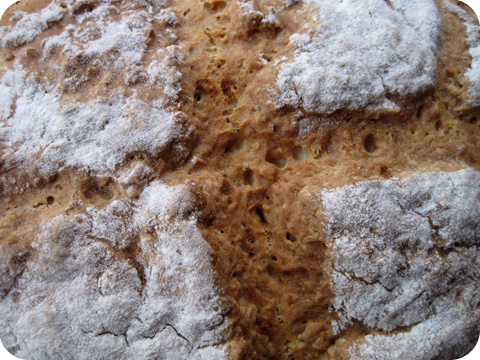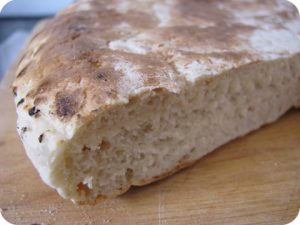One thing I really missed when I was living in the US was good old fashioned soda bread. There was never a shortage of it in our house – every Saturday morning after the cleaning was done my mother would start the baking – soda bread, curney loaf and maybe queen and butterfly cakes if we were good! That smell in the house – of clean and baking is one of the most enduring memories of my childhood.
There are very few things in this life nicer than fresh cut soda bread with melted Kerrygold butter and jam (I’m partial to blackcurrant myself!). At one stage she also got the loan of an old traditional griddle pan and we gorged ourselves on griddle bread for a few weeks – the like Pringles ad – once you pop you can’t stop with griddle bread.
History
Now for something of a history lesson on soda bread! Firstly – we didn’t invent it… the Native American Indians were the first to use it but we have made soda bread our own. Initially it was seen as a way of making bread with poor flour or lack of yeast and since the majority of Irish would have been relatively poor they adopted this method of making bread. Bread soda is said to have been introduced to Ireland in the early 1800’s, some pinpoint it as being about 1835-1840.
Traditionally the ingredients are flour (or self-raising flour), bread soda, salt and buttermilk. The flour used was a fine or cake flour which was lower in gluten than traditional flour. A wheat flour was also substituted to make a wheaten soda in some areas. My own mothers recipe is a quick version passed down from her grandmother that combines both:
Angela’s Soda Bread
- 1lb flour – 10oz white & 6oz brown (adjust for your taste)
- 1 tsp salt
- 1 tsp bread soda
- 2 tsp Bextarter (the rising agent)
- 2 tsp sugar (to take the wild taste from it)
- Buttermilk (enough to moisten the mix)
Sieve the flour from a height to add air and make the bread lighter (with brown flour, the wheaty bits won’t sieve just throw them into the mix after sieving). Then mix all the dry ingredients together – don’t mix too much or you’ll beat the air out of it. Add enough butter milk to give you a sticky, doughy mixture.
Next spread flour over the countertop, roll the mixture out and kneed it – add more flour to the counter if it begins to stick. Kneed it into a round shape and place on a baking tray. Use the palm of your hand to flatten it down to about an inch to 1.5 inches thick and cut into four pieces. It is really something to watch the speed and efficiency of experienced hands doing this! (The bread will still bake as one but will have the familiar soda bread cross making it easy to break – more on this below)
Bake on the middle shelf in a preheated oven at about 200°C for about ½ to ¾ of an hour.
Variations on this recipe include adding raisins (curney loaf) and nuts. It can also be made gluten free by substituting some of the ingredients – the coeliacs society of Ireland has a recipe here.
The Soda Bread Cross
It couldn’t be complete as an Irish tradition if there wasn’t a superstitious story going with the bread. It is said that the cross on the bread is to ward off evil however it is more likely that it is there to promote good circulation of air so that the bread will rise better. Still though – I’ve no problem with a little superstition to ward off evil!
Traditional Baking
In the early 1800’s there were no fancy ovens only open fireplaces and the bread was cooked in what were known as Bastable pots – this gave rise to it being called Bastable cake in some areas. The Bastable pot was a big iron pot with three short legs, a concave lid and a handle for hanging. It would be hung with chains off the crane and sometimes hot turf was placed on the lid to give a good even heat. It could also sit directly into the fire and have the coal or turf built up around it depending on the type of cooking or baking involved.
They are most commonly seen in gardens these days painted glossy black and used as flower pots.
Griddle Bread
Soda bread was quite heavy and could be difficult to digest for older people in the cottage so griddle bread was also cooked which left out the bread soda. This was baked on a griddle pan which is similar to a bake stone – a large circular flat iron slab with flat iron handles on either side. This was either directly on the heat or again suspended by chains. Some griddle pans also had a handle which made it easier to suspend.
The Irish food blog – Toasted Special has a charming article and recipe for griddle bread here. I have to say a big thanks to them for the use of their lovely soda and griddle bread pictures!
Then and now
Cooking utensils and space were extremely limited yet the bean on tí (woman of the house) excelled at making the best of them. Most Irish families would have lived hand to mouth but despite this there was always a way to make it stretch to include the stranger at the gate.
It is a sad reflection of how society and things have changed that we now fear the stranger at the gate. Gone are the days of inviting in the weary for a cuppa tae and a bite to eat – despite having state of the art kitchens, multiple ovens and packed pantries.
Still though, the tradition lives on through inviting friends and neighbours over for a cup of tea, a slice of freshly baked soda bread with Kerrygold butter and jam and a good auld chat!
Websites that could be of interest:
Society for the Preservation of Irish Soda Bread
Coeliac Society of Ireland – Irish Soda Bread, Gluten Free recipie



hi Orla, After read your article, i am glad that i am coming home in 15 days as i so looking forward to a nice cup of Barry Tea with some Soda bread with of course the Kerrygold, can t go wrong there, haha loaded with strawberry jam. When we were younger at home, the mother used to bake, the soda bread and the apple tarts fill with chunky pieces of apple and making sure we left enough room after dinner for it, to be served with plain ice-cream. With the Soda bread she made, she couldn t bake enough… Read more »
Real Estate India…
[…]Reasons to love Ireland – Soda Bread Cottageology – Irish Cottages & Culture[…]…